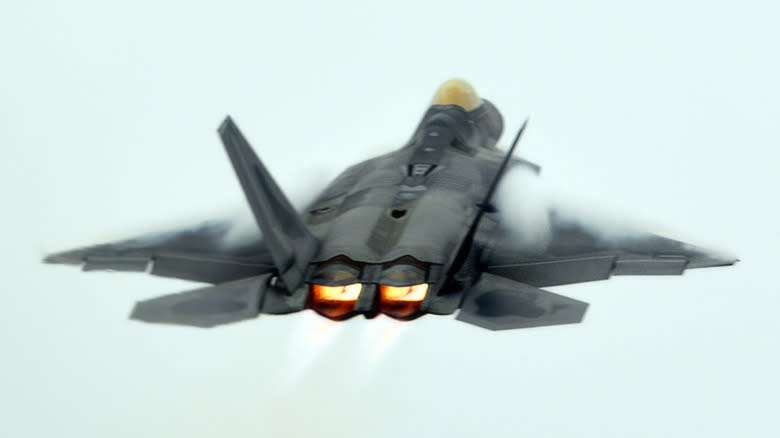
No accolade could better describe how exemplary the F-22 Raptor is as a fighter jet than that its production run was quartered because it was peerless in air-to-air combat. The F-22's rectangular exhaust nozzles are two of many places on the aircraft where stealth, speed and maneuverability were all design considerations. How the exhaust is handled helps the aircraft, co-developed by Lockheed Martin and Boeing, hit a speed of 1,500 miles per hour, twirl through the sky like a falling leaf and remain difficult to spot on radar.
The first thing that onlookers at air shows notice about the F-22 Raptor is the shape of its exhaust nozzle. Most fighter aircraft have circular-shaped exhausts, which seems intuitive when all turbofan engines are cylinders that have to be fitted to the airframe. However, it creates a unique dilemma. According to the Aviation Geek Club, the curved shape can be easier to spot on radar. The angular shape of the F-22's exhausts and the sawtooth edges along the fuselage's aft section are there to minimize the return signature on radar.
Read more: These Are The Worst Transmission Recalls Of The Last 5 Years
The F-22 Raptor Has More Thrust Than Any Other Fighter On The Planet
The thrust vectoring flaps are another feature that contributes to the F-22's unique look. The exhaust-mounted flaps aren't an aesthetic choice. The flaps angle up or down by 20 degrees based on the pilot's inputs and the aircraft's speed to dramatically increase the Raptor's agility. Think of the differential in your car turned up to 11. The F-22 has an unbelievable amount of power to play with, as each of its two Pratt & Whitney F119 engines produces 35,000 pounds of thrust. According to the United States Air Force, the pair of engines produces more thrust than any current fighter engine in service around the world.
Production for the F-22 Raptor was cancelled in 2009, with the last fighter jet leaving the assembly line in 2012. Only 186 Raptors were ever produced, a fraction of the Air Force's initial order of 750 fighters. The F-22 was designed for an era where it needed to have the military might to stand toe-to-toe with Moscow and Beijing. The geopolitical landscape quickly shifted in the 2000s, where air-to-air combat was nearly non-existent in Afghanistan and Iraq. The F-22 Raptor will likely be phased out for more affordable planes over the coming decades, but it will be remembered as an unrivaled feat of aerospace engineering.
Want more like this? Join the Jalopnik newsletter to get the latest auto news sent straight to your inbox...
Read the original article on Jalopnik.








Comments